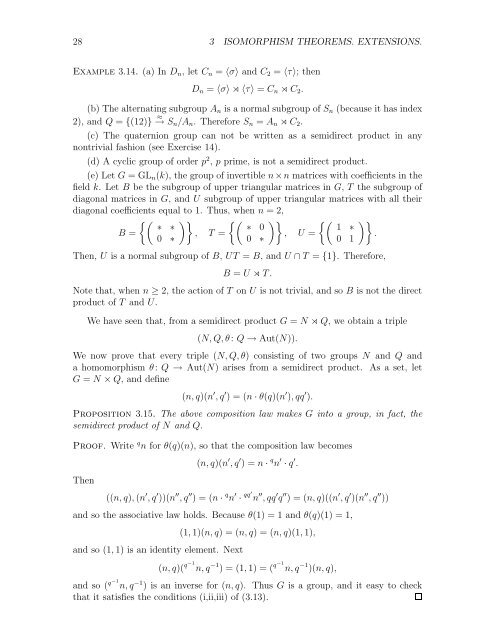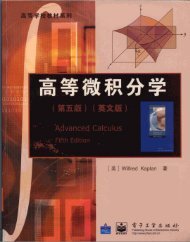Milne - Group Theory.. - Free
Milne - Group Theory.. - Free
Milne - Group Theory.. - Free
Create successful ePaper yourself
Turn your PDF publications into a flip-book with our unique Google optimized e-Paper software.
28 3 ISOMORPHISM THEOREMS. EXTENSIONS.<br />
Example 3.14. (a) In D n ,letC n = 〈σ〉 and C 2 = 〈τ〉; then<br />
D n = 〈σ〉 ⋊ 〈τ〉 = C n ⋊ C 2 .<br />
(b) The alternating subgroup A n is a normal subgroup of S n (because it has index<br />
2), and Q = {(12)} → ≈ S n /A n . Therefore S n = A n ⋊ C 2 .<br />
(c) The quaternion group can not be written as a semidirect product in any<br />
nontrivial fashion (see Exercise 14).<br />
(d) A cyclic group of order p 2 , p prime, is not a semidirect product.<br />
(e) Let G =GL n (k), the group of invertible n × n matrices withcoefficients in the<br />
field k. LetB be the subgroup of upper triangular matrices in G, T the subgroup of<br />
diagonal matrices in G, andU subgroup of upper triangular matrices withall their<br />
diagonal coefficients equal to 1. Thus, when n =2,<br />
{( )} {(<br />
∗ ∗<br />
∗ 0<br />
B =<br />
, T =<br />
0 ∗<br />
0 ∗<br />
)}<br />
, U =<br />
{(<br />
1 ∗<br />
0 1<br />
)}<br />
.<br />
Then, U is a normal subgroup of B, UT = B, andU ∩ T = {1}. Therefore,<br />
B = U ⋊ T .<br />
Note that, when n ≥ 2, the action of T on U is not trivial, and so B is not the direct<br />
product of T and U.<br />
We have seen that, from a semidirect product G = N ⋊ Q, we obtain a triple<br />
(N,Q,θ: Q → Aut(N)).<br />
We now prove that every triple (N,Q,θ) consisting of two groups N and Q and<br />
a homomorphism θ : Q → Aut(N) arises from a semidirect product. As a set, let<br />
G = N × Q, and define<br />
(n, q)(n ′ ,q ′ )=(n · θ(q)(n ′ ),qq ′ ).<br />
Proposition 3.15. The above composition law makes G into a group, in fact, the<br />
semidirect product of N and Q.<br />
Proof. Write q n for θ(q)(n), so that the composition law becomes<br />
Then<br />
(n, q)(n ′ ,q ′ )=n · qn ′ · q ′ .<br />
((n, q), (n ′ ,q ′ ))(n ′′ ,q ′′ )=(n · qn ′ · qq′ n ′′ ,qq ′ q ′′ )=(n, q)((n ′ ,q ′ )(n ′′ ,q ′′ ))<br />
and so the associative law holds. Because θ(1) = 1 and θ(q)(1) = 1,<br />
and so (1, 1) is an identity element. Next<br />
(1, 1)(n, q) =(n, q) =(n, q)(1, 1),<br />
(n, q)( q−1 n, q −1 )=(1, 1) = ( q−1 n, q −1 )(n, q),<br />
and so ( q−1 n, q −1 )isaninversefor(n, q). Thus G is a group, and it easy to check<br />
that it satisfies the conditions (i,ii,iii) of (3.13).

















